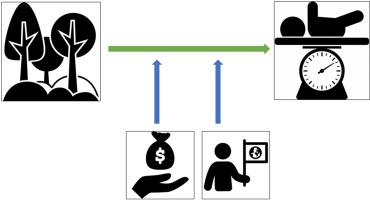Environmental Pollution ( IF 7.6 ) Pub Date : 2021-02-26 , DOI: 10.1016/j.envpol.2021.116814 Selin Akaraci , Xiaoqi Feng , Thomas Suesse , Bin Jalaludin , Thomas Astell-Burt

|
Growing body of research recognizes the importance of green spaces on the perinatal outcomes however, further evidence from different geographies are warranted. We aimed to investigate association between, and differential responses to, maternal exposure to green space and birthweight. Birth records (n = 82,221) were extracted from the Perinatal Data Collection (PDC) in Sydney’s metropolitan area between January 2016 and December 2017. Association between green space quantity and birthweight, term birthweight, low birthweight, term low birthweight and preterm were assessed using linear and logistic regressions. Potential modification by area-level socioeconomic status and maternal country of birth were tested using interaction terms. Difference in birth weight for the ≥40% versus <20% green space within SA2s was 59.0 g (95%CI: 42.9, 75.3) in unadjusted models which dropped to 25.6 g (95%CI: 13.0, 38.2) in adjusted models. Stratified analysis suggested stronger associations for babies of mothers from affluent neighbourhoods, while statistically significant association was not observed in deprived areas. Furthermore, the association was more pronounced among babies to mothers who were born overseas. Associations were consistent for term births. Higher levels of green space were associated with lower odds of preterm birth in adjusted models. However, we did not identify statistically significant association between green space quantity and the risk of low birthweight (LBW). Our study suggests that green space may support healthier birth outcomes and help to reduce the birthweight gap between newborns of mothers born in Australia and overseas. However, disproportionate benefits among women in affluent neighbourhoods may widen socioeconomic inequities in birthweight.
中文翻译:

社区更绿,生育结果更健康?来自澳大利亚的证据
越来越多的研究认识到绿色空间对围产期结局的重要性,但是,来自不同地区的进一步证据是有必要的。我们旨在调查孕妇暴露于绿色空间和出生体重之间的关联以及对孕妇的不同反应。出生记录(n = 82,221)是从2016年1月至2017年12月悉尼大都市地区的围产期数据收集(PDC)中提取的。绿地数量与出生体重,足月出生体重,低出生体重,足月低出生体重和早产之间的关联性使用线性和逻辑回归。使用交互作用术语测试了潜在的地区级社会经济地位和产妇出生国的改变。SA2s内绿色空间≥40%与<20%的出生体重差异为59.0 g(95%CI:42.9,75。3)在未调整型号中降至25.6 g(95%CI:13.0,38.2)。分层分析表明,富裕社区的母亲与婴儿的联系更加紧密,而在贫困地区未观察到统计学上的显着联系。此外,这种关联在婴儿中比在海外出生的母亲更为明显。足月出生的协会是一致的。在调整后的模型中,较高的绿色空间与较低的早产几率相关。但是,我们没有确定绿地数量与低出生体重(LBW)风险之间的统计学显着相关性。我们的研究表明,绿色空间可以支持更健康的分娩结果,并有助于缩小在澳大利亚和海外出生的母亲的新生儿之间的出生体重差距。然而,











































 京公网安备 11010802027423号
京公网安备 11010802027423号